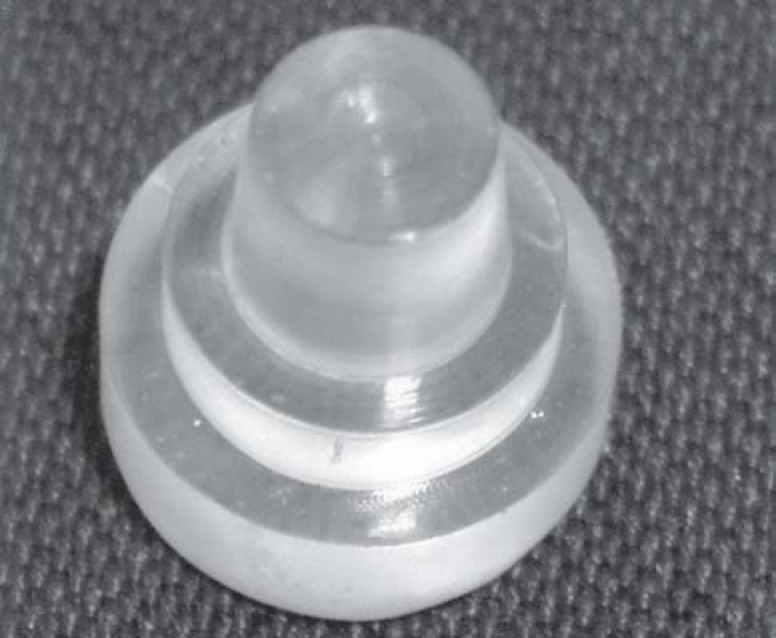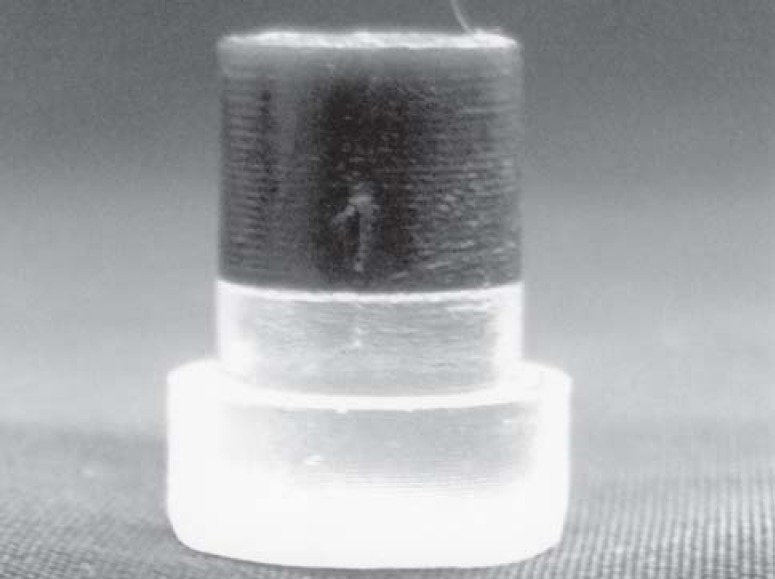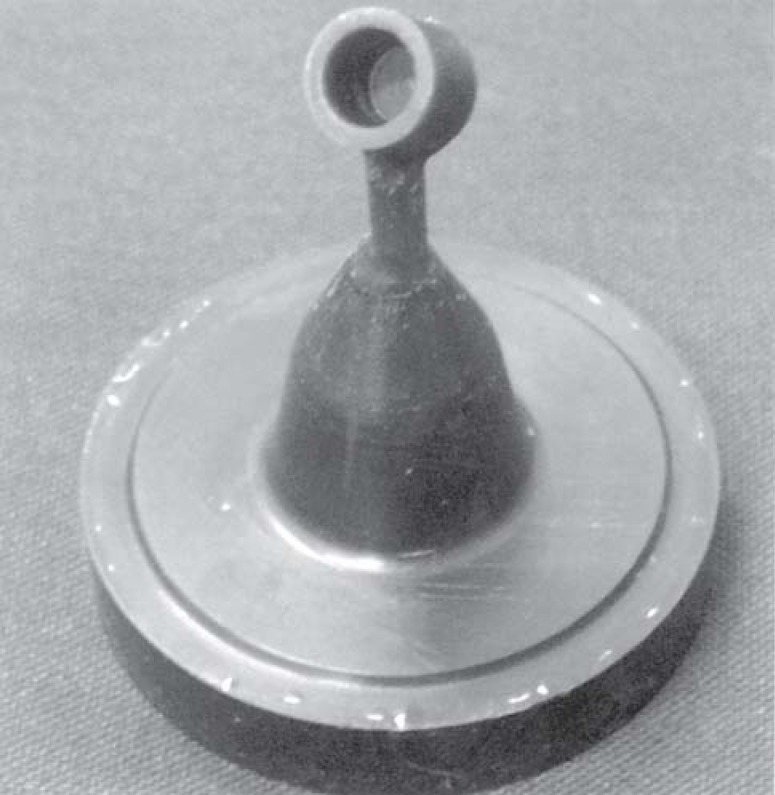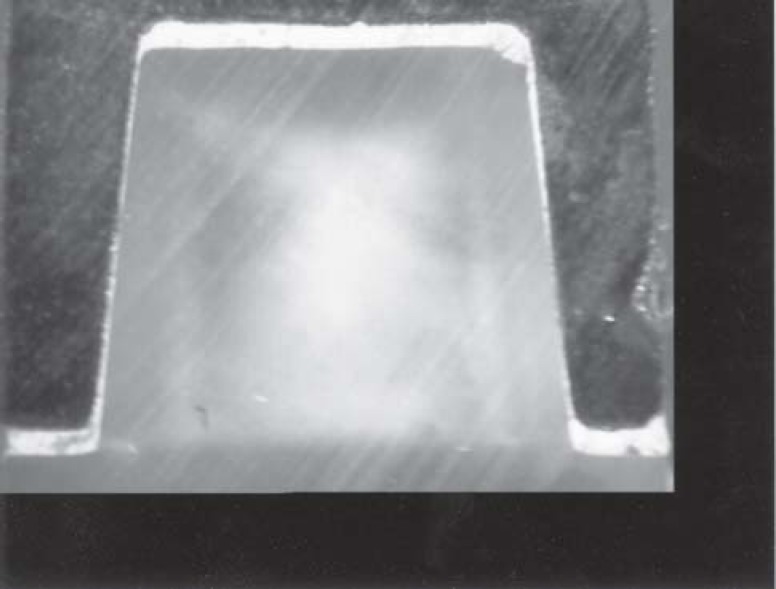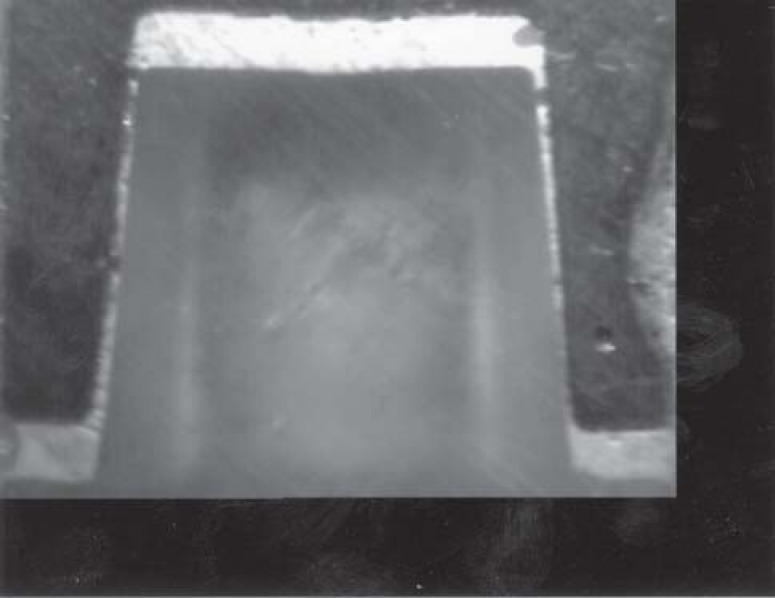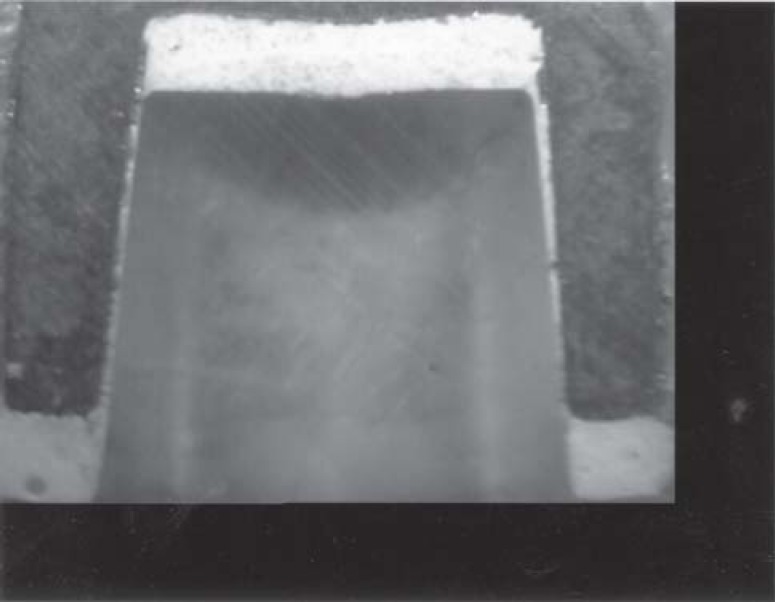Abstract
As the adaptation of titanium crowns obtained by Rematitan Plus investment, specific for titanium, is not recognized to be suitable, this study evaluated the effect of the concentration of the specific liquid and the temperature of the mold of investments on the internal misfit of crowns cast on commercially pure titanium. Individual dies of epoxy resin were obtained, representing teeth prepared for full-crown restoration with a 6-degree axial surface convergence angle and shoulder (1.0 mm). For the waxing of each crown, a ring-shaped stainless steel matrix (8.0mm internal diameter; 7.5 mm height) was adapted above the individual dies of epoxy resin. The Rematian Plus investment was mixed according to the manufacturer's instructions using two different concentrations of the specific liquid: 100%, 75%. Casting was performed in a Discovery Plasma Ar-arc vacuum-pressure casting machine with molds at temperatures of 430°C, 515°C and 600°C. The crowns were cleaned individually in a solution (1% HF + 13% HNO3) for 10 min using a ultrasonic cleaner, with no internal adaptations, and luted with zinc phosphate cement under a 5 kg static load. The crown and die assemblies were embedded in resin and sectioned longitudinally. The area occupied by cement was observed using stereoscopic lens (10X) and measured by the Leica Qwin image analysis system (mm2). The data for each experimental condition (n=8) were analyzed by Kruskal-Wallis non-parametric test (á=0.05). The results showed that liquid dilution and the increase in mold temperature did not significantly influence the levels of internal fit of the cast titanium crowns. The lowest means (±SD) of internal misfit were obtained for the 430°C/100%: (7.25 mm2 ±1.59) and 600°C/100% (8.8 mm2 ±2.25) groups, which presented statistically similar levels of internal misfit.
Keywords: Dental casting investment, Dental alloys, Titanium
INTRODUCTION
Over the last two decades, titanium has been applied in single-tooth and fixed partial dentures1. The increasing dental application of titanium is due to its excellent biocompatibility, high corrosion resistance, low density, high strength/weight ratio, high ductility, low thermal conductivity and adequate mechanical properties12,28,31. The lower density of titanium (4.2 g/cm3), compared to conventional alloys, such as cobalt-chromium (8.9 g/cm3) and gold (19.3 g/cm3), allow the fabrication of prostheses with a light weight without compromising important mechanical properties, such as tensile strength and hardness12,29. In addition, titanium is an inexpensive metal that can be used to create custom cast restorations. Although special investment and casting equipment is needed to make titanium castings, the potential benefit of inexpensive and custom-made restorations is significant22.
The low density, associated with a high melting point (1720°C), and the high chemical reactivity of titanium with elements in the investment19, however, have produced frequent defects, including porosity and castability7,19. The high chemical reactivity of titanium at high temperatures (above 600°C), mainly with silica-based investments, produces a reactive surface layer on the cast (α-case layer)19 that reduces the ductility and the fatigue strength of the structure and clasps of removable partial dentures28,30 and may even compromise the crown fit30.
Special investments containing magnesium oxide (MgO), aluminum oxide (Al2O3), zirconium oxide (ZrO2) and calcium oxide (CaO) have been used to produce a surface with reduced reactivity8,18. However, these materials are expensive and their thermal expansion is not sufficient to compensate for the casting shrinkage of titianium6,17,18. Additionally, these investments do not produce a marginal fit in cast crowns of commercially pure titanium (CP Ti) comparable with those of other alloys, such as Au and Pd-Ag24.
The fit of cast denture restoration is essential for the evaluation of the casting technique, as it may influence the thickness of the cement margin, periodontal soundness, and the risk of secondary caries4, which are decisive factors accounting for the clinical success of restorations.
For a suitable cast crown fit, investment expansion needs to be compatible with the casting shrinkage of the metal. Thus, it is necessary to establish a mold temperature that produces a suitable thermal expansion, which, associated with the setting expansion, may compensate for the cast metal shrinkage. Manufacturers have suggested that the setting and thermal expansions of Rematitan Plus investment, specific for titanium, may be controlled by the concentration of the special liquid, and this has been confirmed by a study by Soo, et al.26 (2001), who evaluated the setting and thermal expansions of Rematitan Plus, Rema Exact and GC Fujivest investments by changing the concentration of their special liquids.
Previous studies, considering the importance of mold temperature25·26 and the concentration of the investment special liquid23 on the quality of titanium casting, found an unsatisfactory fit with the Rematitan Plus investment when using the conditions recommended by the manufacturer, namely, a liquid concentration of 100% and mold temperature of430°C. Thus, the null hypothesis of this study was that the effect caused by the concentration of the special liquid and by the temperature of the mold of Rematitan Plus investment on the internal fit of CP Ti crowns is not significant.
MATERIAL AND METHODS
The tested metal was grade 2 commercially pure titanium (President Titanium., Hanson, MA, USA). Individual polyvinyl siloxane impressions were used to duplicate steel stylized die and create sets of epoxy resin (Epo-Thin; Buehler Uk Ltd., Coventry, West Midlands, England) (Figure 1). The steel dies represent teeth prepared for full-crown molar restoration with the following dimensions: length (6.0 mm), shoulder (1.0 mm), die diameter (7.0 mm), occlusal diameter (5.7 mm), and with a 6-degree axial surface convergence angle. Labial surface was marked with a thin line, and all wax patterns received this mark to ensure proper orientation of crown casting. For waxing of each crown, a ring-shaped stainless-steel matrix, 8.0 mm internal diameter and 7.5 mm height, was adapted above the individual dies of epoxy resin (Figure 2). The individual sprued pattern was mounted on crucible formers so that the length of exposed sprue (4 mm diameter) was about 10 mm (Figure 3). The pattern was then placed in a plastic casting ring (number 3; Dentaurum J. P. Winkelstroeter KG, Pforzheim, Germany). Individual patterns were used with the aim of preventing different specimens from showing the same internal misfit behavior.
FIGURE 1. Epoxy resin die.
FIGURE 2. Wax pattern above the epoxy resin die.
FIGURE 3. The sprued patterns mounted on crucible formers.
Two hundred grams of Rematitan Plus dental casting investment (Dentaurum J. P. Winkelstroeter KG, Pforzheim, Germany) were weighed for each ring and two different concentrations of special liquid, 100% and 75%, diluted in water, were measured with a 25 cm3 pipette, and then mixed according to the manufacturer's instructions. The molds were heated to 150°C for dewaxing, and kept at that temperature for 90 minutes, then heated to 250°C, and kept at that temperature for 90 minutes. Molds were then heated to 1000°C for 1 hour to ensure thermal expansion. Heating was carried out in an electric furnace EDG 7000 (EDG Equipments; São Carlos, SP, Brazil) at 5°C/minute. The molds were slowly cooled inside the furnace to the three different temperatures; 430°C recommended by manufacturer, 600°C (the expansion maximum, according to the expansion curve of the manufacturer) and 515°C (an intermediate value).
At the final temperature, the molds were inserted in the Discovery Plasma Ar-arc vacuum-pressure casting machine (EDG Equipments, São Carlos, SP, Brazil), which consists of two chambers: 1) an upper melting chamber, which houses a copper crucible and a tungsten electrode; and 2) a lower casting chamber placed in the invested mold. For each casting, 22 g of alloy was used.
All castings were carefully removed from the mold, scrubbed under running water and cleaned in water using an ultrasonic cleaner (Ultrasonic Cleaner; Odontobras, Ribeirão Preto, SP, Brazil). Finally, each casting was ultrasonicated individually in a solution (1% HF + 13% HNO3) for 10 min once again. The castings were carefully examined for any irregularities and nodules, with no internal adaptation made. A cutting disc (Dentaurum J. P., Winkelstroeter KG, Pforzheim, Germany) was used to separate the crown from the sprue. Subsequently, all castings were luted with zinc phosphate cement to the individual die epoxy resin under a 5 kg static load5.
The crown and die assemblies were embedded in acrylic resin and sectioned through the long axes with a slow-speed diamond saw (Isomet Saw; Beuhler, Ltd., Lake Bluff, IL, USA) The specimens were bisected buccolingually and one of the cut surfaces of each specimen was finished with 600-grit abrasive paper (Buehler Uk Ltd., Coventry, West Midlands, England), using a rotary equipment (Metaserv 2000; Buehler Uk Ltd., Coventry, West Midlands, England) to remove saw-induced distortions.
Eight specimens per experimental condition were prepared, observed under a stereoscopy lens (10X), and the image was captured by a digital camera (JVC TK1380U CCD; JVC Ltd., Tokyo, Japan) (Figure 4). A Leica Qwin image analysis system (Leica Microsystems Imaging Solutions Ltd., Cambridge, England) was used to measure the area represented by zinc phosphate cement, which corresponded to the area (mm2) of internal misfit of the CP Ti crowns. The misfit occurred in the entire infrastructure/prepared surface interface and there was uniformity between the axial surface, and between the misfit of the occlusal surface and the crown's edge (Figure 4).
FIGURE 4. 430°C/100% group.
Internal misfit means and standard deviations of the 8 specimens of each group were statistically compared using a Kruskal-Wallis non-parametric test (p = 0.05) because the lack of homogeneous variances did not allow the use of parametric statistics.
RESULTS
Table 1 presents the results of Kruskal-Wallis test, comparing the concentrations of the special liquid (100% and 75%) and mold temperatures (430°C, 515°C and 600°C). Tables 2 and 3 display the comparisons between both liquid concentrations at each temperature and among the three temperatures at each special liquid concentration.
TABLE 1. Kruskal-Wallis test results for analysis of differences among groups.
| Value of Kruskal-Wallis (H) | 19.6408 |
| Difference among groups | x2 = 19.64 |
| p = 0.15% |
Significant to the level of 1% (p<0.01)
TABLE 2. Minimum, maximum and mean values (mm2) and standard deviations of internal misfit of the concentrations for each mold temperature.
| Temperature | Concentration | Minimum | Maximum | Means (SD) | Contrast |
|---|---|---|---|---|---|
| 430°C | 100% (n=8) | 4.38 | 8.87 | 7.25 (1.59) | A |
| 75% (n=8) | 5.67 | 10.92 | 8.43 (1.77) | A | |
| 515°C | 100% (n=8) | 8.36 | 10.59 | 9.94 (1.18) | A |
| 75% (n=8) | 9.71 | 13.03 | 11.73 (1.00) | B | |
| 600°C | 100% (n=8) | 5.72 | 11.37 | 8.8 (2.25) | A |
| 75% (n=8) | 6.00 | 13.14 | 9.33 (2.31) | A |
Different letters indicate statistically significant difference at 5%.
TABLE 3. Minimum, maximum and mean values (mm2) and standard deviations of internal misfit of the mold temperatures for each concentration.
| Concentration | Temperature | Minimum | Maximum | Means (dp) | Contrast |
|---|---|---|---|---|---|
| 100% | 430°C (n=8) | 4.38 | 8.87 | 7.25 (1,59) | A |
| 600°C (n=8) | 5.72 | 11.37 | 8.80 (2.25) | AB | |
| 515°C (n=8) | 8.36 | 10.59 | 9.94 (1.18) | B | |
| 75% | 430°C (n=8) | 3.67 | 10.92 | 8.43 (1.77) | A |
| 600°C (n=8) | 6.00 | 13.14 | 9.33 (2.31) | A | |
| 515°C (n=8) | 9.71 | 13.03 | 11.73 (1.00) | B |
Different letters indicate statistically significant difference at 5%.
At 430°C, the concentrations of 100% (7.25 mm2 ± 1.59) and 75% (8.43 mm2± 1.77) presented statistically similar levels of internal misfit (p<0.01). At 515°C, the concentration of 100% (9.94 mm2 ± 1.18) presented lower levels of misfit than the concentration of 75% (11.73 mm2 ± 1.0) (p>0.01). At 600°C, there was no significant difference between the concentrations of 100% (8.8 mm2 ± 2.25) and 75% (9.33 mm2 ± 2.31) (p>0.01) (Figures 4–6).
FIGURE 6. 600°C/100% group.
FIGURE 5. 515°C/75% group.
With regard to the different liquid concentrations, at 100% concentration, the temperature of430°C (7.25 mm2) presented a smaller misfit than at 515°C (9.94 mm2) and was statistically similar to the misfit obtained with 600°C (8.8 mm2), which did not demonstrate any significant difference at 515°C. At a concentration of 75%, the temperatures of430°C (8.43 mm2) and 600°C (9.33 mm2) presented statistically similar levels of internal misfit, which were lower than those obtained at 515°C (11.73 mm2).
Considering the combinations of liquid concentration and mold temperatures on the casting of Rematitan Plus investment, the groups 430°C/100% and 600°C/100% were statistically similar, presenting the lowest levels of internal misfit (7.25 mm2and 8.8 mm2, respectively).
DISCUSSION
The special liquid of Rematitan Plus investment consists of a colloidal silica solution in water, and it is used with the purpose of adjusting setting and thermal expansions by its dilution in water14. The manufacturer suggests that both expansions may be increased by controlling the concentration of the special liquid, to compensate the metal and wax pattern.
Among the several factors that may compensate for the metal casting shrinkage occurring during the casting process, setting and thermal expansions are recognized as the most important16. Morey20 (1992) suggested that the setting expansion of the investment should be near 0.05%, sufficient just to harmonize with wax expansion. Another study3 confirmed this statement, reporting that investments with low setting expansions were less affected by restriction forces, and suggested that investments undergo the smallest setting expansion possible, to avoid distortion of the wax pattern, and high thermal expansion to compensate for the casting shrinkage of the metal20.
In addition to the concentration of the special liquid, mold temperature may be varied in an attempt to adjust the thermal expansion to the thermal shrinkage coefficient of titanium28,29. When used as recommended by the manufacturer (100%/ 430°C), Rematitan Plus investment, specific for titanium, did not provide fit levels that were comparable to those of conventional alloys21. Taking this into consideration, the present study investigated the effect of altering the concentration of the special liquid and the mold temperature for Rematitan Plus investment on both setting and thermal expansions, on the internal misfit of CP Ti crowns.
At temperatures of430°C and 600°C, the dilution of 75% special liquid did not significantly increase internal misfit levels. On the other hand, at 515°C, this dilution resulted in a significant increase in internal misfit levels (Table 2). These results showed that dilution of Rematitan Plus investment liquid did not improve the internal misfit levels of CP Ti crowns; rather, at 515°C, it resulted in higher internal misfit levels.
Hutton and Marshall9 (1993) demonstrated a large reduction in the investment setting expansion with the dilution of special liquid in distilled water. This occurs because there is higher silica content in the concentrated special liquid, which increases the silica-based investment setting expansion8. Soo, et al.26 (2001) also observed an increase in the setting and thermal expansions with the increase in the concentrations of the special liquid of Rematitan Plus, Rema Exakt and GC Fujivest investments.
Although no significant difference was found between the 100% and 75% concentrations at 430°C and 600°C, a trend for increased internal misfit levels of the CP Ti crowns was observed with dilution of Rematitan Plus investment special liquid. This may have occurred due to the decrease of total expansion with liquid dilution, confirming the findings of Low and Mori16(1999), who reported a high correlation coefficient (R=0.87) between the thermal expansion and the dimension accuracy of titanium cast crown.
Considering the concentrations of special liquid evaluated, 100% and 75%, the temperature of 515°C resulted in a significant increase in the internal misfit levels (Table 3). However, there was no statistically significant difference between these concentrations at 430°C and 600°C. The increase in mold temperature may cause an increase in thermal expansion and a consequently higher compensation of titanium shrinkage casting, producing crowns with lower misfit levels. On the other hand, Inoue, et al.11(2001) evaluated the dimensional changes and setting accuracy of CP Ti crowns, obtained under various mold temperatures, and observed a increase in the misfit with the increase of mold temperature. Still according to Inoue, et al.11(2001), the misfit of the occlusal portion of the crown was greater than that of the cervical portion. This supposedly occurred due to the higher heating of the occlusal surface by the cast titanium because the sprue was located in the center of that surface11.
The results of the present study suggest that other factors may be more important than the increase in total expansion. The reaction layer of the titanium surface is a probable factor, considering that titanium has a high chemical reactivity at elevated temperatures13,24,28.
The higher internal misfit levels obtained at 515°C compared to 600°C, when using the 75% concentration, probably occurred because the total internal expansion at 515°C was not sufficient to compensate for the effect of the reaction layer on titanium surface. On the other hand, at 600°C, although the reactivity of the layer is higher due to the higher temperature, the higher expansion was probably compensated, in part, by the reaction layer.
In conclusion, the changes in the concentration of the special liquid and mold temperature of Rematitan Plus investment did not result in any improvement in the internal misfit levels of the CP Ti casting crowns, compared to the conditions recommended by manufacturers, i.e. 100% liquid concentration and a mold temperature of430°C.
Given that conventional preheating furnaces are of low accuracy (more than 10°C/minus from the nominal temperature shown in the display) and that it usually takes more than 2 minutes before casting is completed after removal of molds from the oven, it is difficult to determine the real temperature of the mold at the moment of casting. This could be considered a limitation of the present study.
Although the fit of titanium casting crowns has been evaluated10,14,23,30, most available information refers to marginal fit. The lack of studies addressing internal misfit based on the evaluation of cement area (mm2) together with differences in methodologies hinder any comparisons of the study outcomes. However, a possible relation between the values of internal and marginal misfit may be expected because the discrepancy that occurred on the occlusal surface of the die seems to correspond to that of the cervical margin.
Thus, the clinical benefit of the internal fit test is that it may represent an important tool to evaluate denture structure fit. Al Wazzan and Al-Nazzawi1 (2007) evaluated marginal and internal fit of CP Ti and Ti-6Al-4V crowns and showed that Ti-6Al-4V had less fit discrepancy than CPTi. However, both castings were considered clinically acceptable. Several authors agree that a marginal gap of less than 100 μm appears to be within the acceptable range for clinical longevity restorations2,14,18. Mid-occlusal internal fit has been shown to present better gap discrepancy than the axial internal fit.
These results are consistent with those of the present study, as shown on Figures 4–6. The most plausible explanation for the difference in the internal discrepancy between occlusal and axial areas is the expansion behavior of the investment material in the casting ring. During setting expansion, the axial surfaces are substantially restricted because it is oriented towards an open end of the investment ring. Moreover, thermal expansion of the investment may further allow the occlusal surface to expand more during wax elimination, consequently increasing the occlusal internal gap1. Further research is needed to clarify the favorable relationship between the cement space and the casting shrinkage value32.
CONCLUSION
Within of limits this study, the following conclusions may be drawn. Dilution of the special liquid of Rematitan Plus investment did not result in any improvement in the levels of internal fit of the commercially pure titanium cast crowns, regardless of mold temperature. In addition, at a mold temperature of 515°C, regardless of liquid concentration, a significant increase in internal fit levels was observed, thus rejecting the null hypothesis.
REFERENCES
- 1.Al Wazzan KA, Al-Nazzawi AA. Marginal and internal adaptation of commercially pure titanium and titanium-aluminum-vanadium alloy cast restorations. J Contemp Dent Pract. 2007;8:19–26. [PubMed] [Google Scholar]
- 2.Contreras EFR, Henriques GEP, Giolo SR, Nobilo MAA. Fit of cast commercially pure titanium and Ti-6Al-4V alloy crowns before and after marginal refinement by electrical discharge machining. J Prosthet Dent. 2002;88:467–472. doi: 10.1067/mpr.2002.128954. [DOI] [PubMed] [Google Scholar]
- 3.Earnshaw R. The effect of restrictive stress on the setting expansion of gypsum bonded investment. Aust Dent J. 1964;9:169–176. doi: 10.1111/j.1834-7819.1969.tb03328.x. [DOI] [PubMed] [Google Scholar]
- 4.Felton DA, Kanoy BE, Bayne SC, Wirthman GP. Effect of in vivo crown margin discrepancies on periodontal health. J Prosthet Dent. 1991;65:357–364. doi: 10.1016/0022-3913(91)90225-l. [DOI] [PubMed] [Google Scholar]
- 5.Fonseca RG, Cruz CAS, Adabo GL, Vaz LG. Comparison of the tensile bond strengths of cast metal crowns luted with resin cements. J Oral Rehabil. 2004;31:1–5. doi: 10.1111/j.1365-2842.2004.01345.x. [DOI] [PubMed] [Google Scholar]
- 6.Hamanaka H, Doi H, Yoneyama T, Okuno O. Dental casting of titanium and Ni-Ti alloys by a new casting machine. J Dent Res. 1989;68:1529–1533. doi: 10.1177/00220345890680111201. [DOI] [PubMed] [Google Scholar]
- 7.Hero H, Syverud M, Waarli M. Mold filling and porosity in casting of titanium. Dent Mater. 1993;9:15–18. doi: 10.1016/0109-5641(93)90098-b. [DOI] [PubMed] [Google Scholar]
- 8.Hung CC, Hou GL, Tsai CC, Huang CC. Pure titanium casting into zirconia–modified magnesia–based investment molds. Dent Mater. 2004;20:846–851. doi: 10.1016/j.dental.2003.10.016. [DOI] [PubMed] [Google Scholar]
- 9.Hutton JE, Marshall GW. The expansion of phosphate bonded investments: Part I – setting expansion. J Prothest Dent. 1993;70:121–125. doi: 10.1016/0022-3913(93)90005-9. [DOI] [PubMed] [Google Scholar]
- 10.Ida K, Togaya T, Tsutsumi S, Takeuchi M. Effect of magnesia investment in dental casting of pure titanium and titanium alloys. Dent Mater J. 1982;1:8–21. doi: 10.4012/dmj.1.8. [DOI] [PubMed] [Google Scholar]
- 11.Inoue T, Inoue A, Asai M, Komasa Y. Fit and dimensional changes of cast CP titanium crowns fabricated using sintered molds. Dent Mater J. 2001;3:195–205. doi: 10.4012/dmj.20.195. [DOI] [PubMed] [Google Scholar]
- 12.Jones TK, Hansen CA, Singer MT, Kessler HP. Dental implications of nickel hypersensitivity. J Prosthet Dent. 1986;56:507–509. doi: 10.1016/0022-3913(86)90398-7. [DOI] [PubMed] [Google Scholar]
- 13.Lautenschlager E, Monaghan P. Titanium and titanium alloys as dental materials. Int Dent J. 1993;43:245–253. [PubMed] [Google Scholar]
- 14.Leong D, Chai J, Lautenschlager E, Gilbert J. Marginal fit of machine-milled titanium and cast titanium single crowns. Int J Prosthodont. 1994;7:440–447. [PubMed] [Google Scholar]
- 15.Lloyd CH, Yearn JA, Cowper GA, Blavier J, Vanderdonckt M. Measurement of the setting expansion of phosphate-bonded investment materials: Part I – development of the casting-ring test. J Oral Rehabil. 2004;31:695–702. doi: 10.1111/j.1365-2842.2004.01292.x. [DOI] [PubMed] [Google Scholar]
- 16.Low D, Mori T. Titanium full crown casting: thermal expansion of investments and crown accuracy. Dent Mater. 1999;15:185–190. doi: 10.1016/s0109-5641(99)00031-7. [DOI] [PubMed] [Google Scholar]
- 17.Luo XP, Guo TW, Ou YG, Liu Q. Titanium casting into phosphate bonded investment with zirconite. Dent Mater. 2002;18:512–515. doi: 10.1016/s0109-5641(01)00076-8. [DOI] [PubMed] [Google Scholar]
- 18.McLean JW, Von Fraunhofer JA. The estimation of cement film thickness by an in vivo technique. Br Dent J. 1971;131:107–111. doi: 10.1038/sj.bdj.4802708. [DOI] [PubMed] [Google Scholar]
- 19.Miyakawa O, Watanabe K, Okawa S, Nakano S, Kabayashi M, Shiokawa N. Layered structure of cast titanium surface. Dent Mater J. 1989;8:175–185. doi: 10.4012/dmj.8.175. [DOI] [PubMed] [Google Scholar]
- 20.Morey EF. Dimensional accuracy of small gold alloy castings. Part 3. Gypsum-bonded investment expansion. Aust Dent J. 1992;37:43–54. doi: 10.1111/j.1834-7819.1992.tb00833.x. [DOI] [PubMed] [Google Scholar]
- 21.Mori T, Jean-Louis M, Yabugami M, Togaya T. The effect of investment type on the fit of cast titanium crowns. Aust Dent J. 1994;39:348–352. doi: 10.1111/j.1834-7819.1994.tb03104.x. [DOI] [PubMed] [Google Scholar]
- 22.Ohkubo C. The machinability of cast titanium and Ti-6Al-4V. Biomaterials. 2000;21:421–428. doi: 10.1016/s0142-9612(99)00206-9. [DOI] [PubMed] [Google Scholar]
- 23.Oruç S, Tulunoglu Y. Fit of titanium and a base metal alloy metal-ceramic crown. J Prosthet Dent. 2000;83:314–318. doi: 10.1016/s0022-3913(00)70134-x. [DOI] [PubMed] [Google Scholar]
- 24.Papadopoulos T, Axelsson M. Influence of heating rate in thermal expansion of dental phosphate – bonded investment material. Scand J Dent Res. 1990;98:60–65. doi: 10.1111/j.1600-0722.1990.tb00940.x. [DOI] [PubMed] [Google Scholar]
- 25.Schimitt SM, Chance DA. A custom titanium implant-retained single-tooth restoration: a clinical report. Int J Oral Maxillofac Implants. 1996;11:782–786. [PubMed] [Google Scholar]
- 26.Soo S, Palmer R, Curtis RV. Measurement of the setting and thermal expansion of dental investments used for the superplastic forming of dental implant superstructures. Dent Mater. 2001;17:247–252. doi: 10.1016/s0109-5641(00)00078-6. [DOI] [PubMed] [Google Scholar]
- 27.Stoll R, Makris P, Stachniss V. Marginal adaptation of cast partial crowns made of pure titanium and a gold alloy under influence of a manual burnishing technique. J Oral Rehabil. 2001;28:401–406. doi: 10.1046/j.1365-2842.2001.00681.x. [DOI] [PubMed] [Google Scholar]
- 28.Sunnerkrantz PA, Syverud M, Hero H. Effect of casting atmosphere on the quality of Ti crowns. Scand J Dent Res. 1990;98:268–272. doi: 10.1111/j.1600-0722.1990.tb00972.x. [DOI] [PubMed] [Google Scholar]
- 29.Takahashi J, Kimura H, Lautenschlager EP, Chern Lin JH, Moser JB, Greener EH. Casting pure titanium into commercial phosphate – bonded SiO2 investments molds. J Dent Res. 1990;69:1800–1805. doi: 10.1177/00220345900690120301. [DOI] [PubMed] [Google Scholar]
- 30.Tamaki Y. Titanium casting with newly developed phosphate bonded investments. J Dent Res. 1991;70:485–485. [abstract n. 1755] sp. issue. [Google Scholar]
- 31.Wang RR, Boyle AM. A simple method for inspection of porosity in titanium castings. J Prosthet Dent. 1993;70:275–276. doi: 10.1016/0022-3913(93)90065-v. [DOI] [PubMed] [Google Scholar]
- 32.Zinelis S. Effect of pressure of helium, argon, krypton, and xenon on the porosity, microstructure, and mechanical properties of commercially pure titanium castings. J Prosthet Dent. 2000;84:575–582. doi: 10.1067/mpr.2000.109479. [DOI] [PubMed] [Google Scholar]



